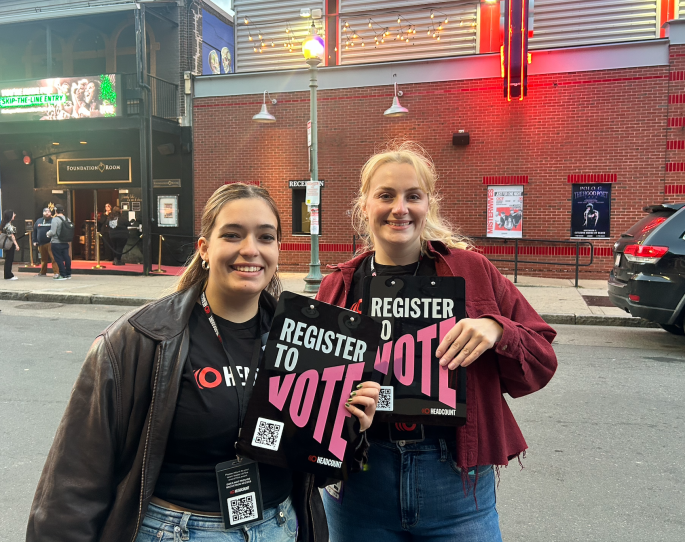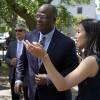On a fall Wednesday night, young people eagerly stood in line to enter MGM Music Hall at Fenway for Gracie Abrams’ brand new “Secret of Us Tour.” As excited fans debated which song Abrams would start the concert with, three volunteers wearing Headcount shirts approached the queue with a QR code.
Headcount is a nonprofit, nonpartisan organization that seeks to equip voters with the tools and knowledge they need to cast their votes. They do this by partnering with artists like Abrams, Sabrina Carpenter and Remi Wolf. At the shows, volunteers offer merchandise giveaways and handing out pins to encourage folks to double-check their registration.
”People might not be thinking about politics when they go see their favorite artists perform, but seeing us at the table is a unique way to get those people involved in politics,“ said Emily Bresnahan, a New England regional coordinator for Headcount.
Jaya Gupta, 18, was waiting in line outside MGM Music Hall for the Gracie Abrams concert when she heard about Headcount. Although the Massachusetts native has her father as a resource to navigate her first time voting, she says having an organization like Headcount is beneficial for other young voters.
”I think that organizations like Headcount make it easier for people to begin their voting process by providing them with easy access to their voter information,“ Gupta said.

Concerts aren’t the only places where young people are encouraging each other to vote; college campuses are also hot spots.
With more than 30 higher education institutions within city limits, multiple Boston colleges and universities already have nonpartisan campus-wide initiatives to ensure their students are equipped to engage in their civic responsibility.
In downtown Boston, Suffolk University has Suffolk Votes, a staff, faculty and student collaboration aimed at making the voting process easier by providing voter registration forms, reminding students to register to vote, and notifying them about upcoming deadlines.
Rachael Cobb, associate professor of political science and legal studies at Suffolk University, said students genuinely want to participate in the democratic process but that they need guidance.
“For many, it’s their first time voting, and we’re all scared when it’s our first time to do anything,” said Cobb, “So, we as a community and a society need to do all we can to support them.”
A few miles down the road, Northeastern University and its coalition Northeastern Votes have also worked hard to promote voter registration, education and turnout.
Hilary Sullivan, director of community service and civic engagement at Northeastern University, said that prior to the creation of the coalition, it was the university’s student government that mobilized around election time to increase participation. However, Sullivan says the goal was to institutionalize these practices to ensure that anytime a student became eligible to vote, they had the resources they needed available.
“This year, we were certainly doing a lot because it’s a big presidential election,” said Sullivan, “But we’re really trying to ensure that students are voting in city and state elections as well.”
Youth voter engagement has trended up in recent years.
Tufts University has been studying these trends since 2012. According to theirNational Study of Learning, Voting, and Engagement, student voter turnout surged during the past presidential election, reaching an unprecedented 66%, surpassing the 52% in 2016.
Jen McAndrew, senior director of communications and planning at the Jonathan M. Tisch College of Civic Life of Tufts University, said the university decided to focus on higher education institutions as they play a vital role in increasing youth civic engagement.
“One of the primary core tenets of American higher education is the civic purpose of preparing Americans for robust civic life,” McAndrew said, “So, in this study we look at these institutions that have historically been places of civic learning and development to understand the trends among young voters.”
Across the Charles River in Cambridge, Julia High and Jordan Schwartz co-lead Harvard Votes Challenge.
“Our biggest goal is to increase visibility and accessibility,” Schwartz said. “Visibility in the sense that we want everyone to know that we exist and know that we have the resources for them, and accessibility in actually having those resources ready for them so that the voting process — which is not always easy as a college student — can be as easy as possible.”
Though these initiatives may positively impact voter registration on campus, it is peer-to-peer initiatives that have proven to be most effective, school representatives say.
“At Suffolk, we engage students socially around voting and encourage them to vote because their friends are voting,” said Cobb, “And so it becomes part of the culture of our university, that we are a university that votes.”
Similarly, at Northeastern University and Harvard University, most of their programming is built around student-led events to engage fellow students.
Matias Gonzalez, a student leader at Northeastern University, emphasized the importance of student-led conversations.
“It can seem kind of daunting to get help from your professors, but when you talk to a peer, it can just be a casual conversation along the lines of I know it’s hard, but let’s chat about some resources,” he said.

All these efforts may raise registration rates, but they do not always translate to casted ballots, particularly among first-time voters.
Despite the historic turnout in the 2020 presidential election, the overall voting rate in the 2022 midterm race was down to31%, lower than in 2018.
Absentee voting, students say, can be especially challenging.
“Every state has different rules, which makes it confusing. They have different rules about early voting and mail-in voting. And so it’s not the same process for every student,” said Rachael Cobb.
Julia High, a junior at Harvard College, said that despite being a co-chair for Harvard Votes, she experienced difficulty getting her ballot from Florida in the upcoming election.
“I requested my ballot online, but my mailing address was not showing up,” High said, “I had to call my local elections office, but they did not know the answer.”
High had to call a second time to figure out what the problem was with her ballot. That process, she says, would prevent some of her peers from casting their vote.
Schwartz experienced a different challenge with his home state of Ohio. He requested a ballot last year but never received it, despite applying weeks in advance.
“This fall, we have been trying to encourage as many people as possible to request their absentee ballots as early as possible so that way you can check it, you can track it, and if there is a problem, halfway through October, you can solve it by calling your elections office,” he said.
Savanna Ruzzano, a first-year student and Northeastern Votes ambassador at Northeastern University, noticed that the presence of ambassadors on campus helped her peers navigate the often complicated process.
“We can help you get stamps, envelopes, mail anything in, print out forms,” said Ruzzano, ”We are just trying to make it easier so students don’t get frustrated and give up.”
Despite the challenges, most college student leaders continue to be optimistic and hope that their efforts increase voting access for their peers.
“Voting matters,” said Matias Gonzalez, who is voting by mail in Arizona.
“This election is not all about the big ticket. It’s not all about the president,” he said, “Look at your ballot, do some research; there might be other important issues at stake.”
Produced with assistance from the Public Media Journalists Association Editor Corps funded by the Corporation for Public Broadcasting, a private corporation funded by the American people.








